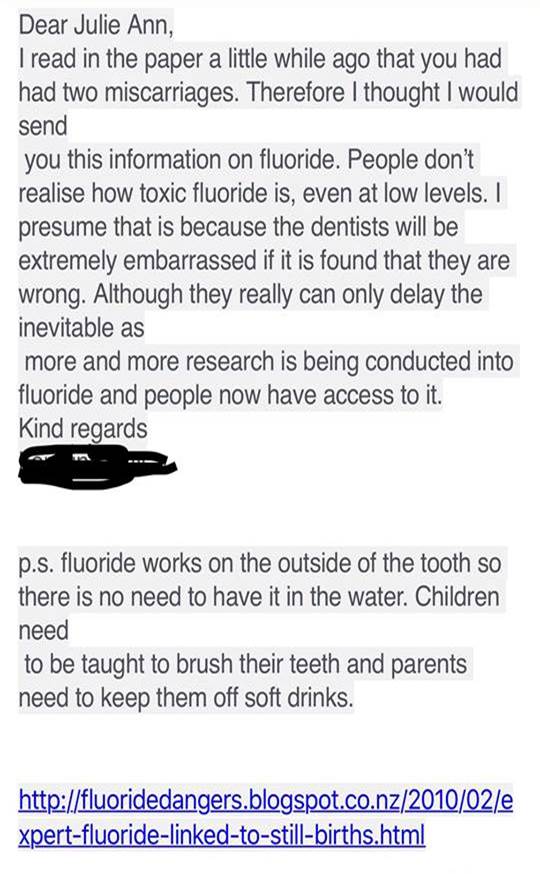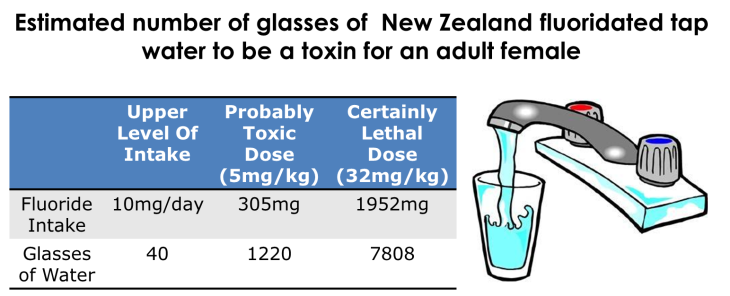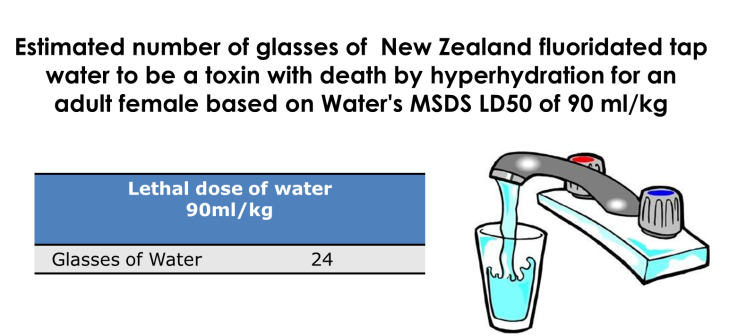Dear Lorraine,
I noticed that last week you chose to send this message to Green Party MP Julie Anne Genter:

Having read the original message I’ve decided not to identify you other than by your first name (Lorraine), however I do want to say that I was really shocked at the insensitivity of your message – let alone the bad science (I’ll come to that). I decided to create a flowchart for you to follow for the next time that you decide to interact with another human being, especially when communicating with people that you don’t know. I’ve called it “Lorraine’s Flow Chart” as it was written with you in mind, but feel free to share it with others.

Lorriane’s Flow Chart For Future Communications With Other Humans
Now, as promised, I would like to clarify some of the science behind your comments.
You wrote:
“People don’t realise how toxic fluoride is, even at low levels”
As you don’t offer any form of reference to your statement, firstly I don’t know who you mean by ‘people’, or what you are classing as a ‘low’ level of fluoride.
Let me offer some scientific evidence:
In a recent paper in the American Journal of Public Health titled “Community Water Fluoridation and Intelligence: Prospective Study in New Zealand” the researchers are very clear in their findings. They conducted a study on a sample of the general population from people born in Dunedin, New Zealand, between April 1, 1972 and March 30, 1973 and followed them for 38 years. They found “No clear differences in IQ because of fluoride exposure even after adjusting for potential confounding variables, including sex, socioeconomic status, breastfeeding, and birth weight (as well as educational attainment for adult IQ outcomes).
Their peer reviewed conclusion specifically states that:
These findings do not support the assertion that fluoride in the context of community water fluoridation programs is neurotoxic.
I used this example because it is an amazing, peer reviewed, long-term study of the effects of fluoride in a New Zealand context, which is where you, Julie Anne and I live.
Next point. In your message you state that “People don’t know how toxic fluoride is”, and you might be right. So I thought I’d do some calculations, because it is toxic if you consume too much of it. So of course is vitamin D, calcium and even water…does this mean we need to start warning people about the dangers of drinking water too?
The amount of fluoride in our water supply is adjusted to keep our water supply level to between 0.7 ppm and 1.0 ppm. This is the optimal amount that provides protection against tooth decay, and is monitored to make sure that the levels stay within that range.
So how much fluoridated water would you have to drink before you die from toxicity?
To help out, I decided to make some calculations for you. I’ve based my calculations Ln taking a look at your LinkedIn profile and estimating that you are an adult female weighing around 68kg. (If I am incorrect on your weight, please feel free to correct me and I will re-calculate for you).
Based on this assumption I made you a personal “Fluoride in New Zealand Tap Water Toxicity” chart:

Table showing that it would take 1220 glasses of fluoridated tap water to possibly be toxic to Lorraine when considering fluoride toxicity risks
So perhaps your next email about the toxicity of fluoride should be more clear and state that “even at levels of fluoride that are in New Zealand tap water, you would need to drink 1220 glasses of water in a day for it to be possibly toxic”.
I think you are missing a very important point. Perhaps your messages should be less concerned about the levels of fluoride in the water, and more concerned about the dangers of water itself!
I looked up the MSDS (materials safety data sheet) for water which states that:
From this I calculated your personal water toxicity risk:

Table showing that it would take 24 glasses of fluoridated tap water to possibly be toxic to Lorraine when considering hyperhydration
This means that the water itself is far more toxic than the fluoride in it. If you want to give medical and scientific advice to people that you don’t know then you should probably focus on the much higher chance that somebody dies from hyperhydration by drinking 24 glasses of water, than the…highly achievable…7000 glasses of water needed for death by fluoride toxicity.
Your next statement says that you think:
“dentists will be extremely embarrassed if it is found that they are wrong”
The thing is, science doesn’t work that way. We scientists don’t become embarrassed if we are found wrong – we love it.
Why?
Let me explain scientific method to you.
Although anybody can do science, professional scientific researchers follow a scientific method which allows them to explain occurrences using a logical, consistent, systematic method of investigation.
This involves collecting large amounts of data from well thought-out experiments and analysing that data to arrive at a well-tested, well documented theory that is supported by the evidence. The theory is then subjected to critique by other experts in the field and only if approved by them is it allowed to be published in a peer reviewed journal for others to read and learn from. We can be wrong for sure, but it’s very difficult to publish wrong data without it being picked up. It’s almost impossible for hundreds of scientists to publish the same wrong data – it’s actually our job as peer reviewers of other people’s science to pick holes in research, trying to prove that it is wrong before allowing it to be published. So there is no embarrassment in science, just a rigorous method.
You say that:
“More and more research is being conducted into fluoride“
You are right, and ‘s the great thing about science: we continue to research to find out things that we don’t know. I spent 7 years of my life researching fluoride, and even back then there had already been a lot of research carried out. For instance, we knew then what we know now – that the levels of fluoride in the tap water in New Zealand are not toxic, and in fact have been shown to have positive outcomes for our population, including:
- In children and adolescents, a 40 per cent lower lifetime incidence of dental decay (on average) for those living in areas with water fluoridation.
- For adults, a 21 per cent reduction in dental decay for those aged 18 to 44 years and a30 per cent reduction for those aged 45+ (as measured by tooth surfaces affected).
- A 48 per cent reduction in hospital admissions for treatment of tooth decay, for children up the age of four years.
Finally, I took a look at the link that you included, which was notably to a blog site rather than to a peer reviewed scientific article. Carol S. Kopf, the author of the blog, is also the media director for the Fluoride Action network, an international coalition to end water fluoridation. As you might expect, her views are heavily biased against fluoride.
The blog post refers to research from Dr A.K. Susheela of India who states that she talked about the results of her studies on women ingesting fluoride at the 27th Conference of the International Society for Fluoride Research, Beijing, China, Oct. 2007. Her study was called: Fluoride Ingestion and Health Hazards with Focus on Anaemia in Pregnancy and low birth weight babies: Guidelines for rectification: Susheela A.K, Mondal NK, Rashmi G, Ganesh Kamala, Bhasin Shammi, Gupta Gunjan.
So I looked everywhere for a peer reviewed conference paper that Dr Susheela would have written up, which is how science that is presented at conferences is assessed to be accurate with good scientific method. I couldn’t find any.
I did however manage to find one research paper written by Dr Susheela which seems to be connected to this blog statement in her paper “Effective interventional approach to control anaemia in pregnant women“, published in the journal Current Science, a science journal from India.
Science journals are ranked using an impact factor which is used to compare different journals within a certain field. For example the highly regarded The New England journal of medicine has an impact factor of 59.558 and the medical journal The Lancet has an impact factor of 44.002. By way of comparison Current Science has an impact factor of 0.83.
The study that the link you provided could be loosely connected to involved only women in India who were already pregnant, medically anemic and showed high levels of fluoride in their blood.
Just to be clear, India is one of several countries known to have dangerously high levels of fluoride in their drinking water, with villages like Sogival having groundwater fluoride levels of 4.84 ppm. Not only is their water naturally high in fluoride, but the women in this study were also eating black rock salt, a type of salt with high levels (157 ppm) of fluoride commonly found in Indian street food and Indian snacks and spices.
The link that you refer to is not a study that links fluoride to miscarriages and stillbirths as you claim. If you actually read the research you would see that its a study on pregnant women in a “developing country” who are already anaemic, ingesting high levels of fluoride and suffering from other risk factors including dietary deficiencies, parasitic infestations, urinary tract infections and malaria.
The paper itself is clear in it’s conclusion and states:
“The first factor (application of intervention) throws up a bit of a confusing result to which we do not have a concrete answer at the moment”
They find no concrete evidence that the very high levels of fluoride are directly correlated to the low birth weight of some of the babies, but – as you can see when you read the paper – the women in this study are already unwell when judged by western medicine standards.
Back to your original, offensive advice for Julie-Anne. In New Zealand miscarriage affects 1 in every 4 women. Having a miscarriage can be traumatic and many women experience huge grief over their loss. It is a very sensitive subject and very personal to those involved. If you haven’t had to experience the grief of a miscarriage or the challenges around infertility then please understand that it can involve pain, a sense of loss, and a daily struggle to try and remain positive while sometimes feeling like a failure.
In closing, I’d like to leave you with a quote that a colleague of mine has on her office wall that I love and hope you might too:
“We’re all smart. Distinguish yourself by being kind“
Excellent response and well crafted scientific communication, thank you for sharing this with us.
Brilliant Michelle!
I love science. Great article which I have shared on Facebook in the hope that my woo loving friends will take the time to read. (but will probably not as they will be too busy sharing David Avocado Arsehat Wolfe memes).
[…] UPDATE: Michelle Dickinson has a wonderful response on her blog. […]
Great post. Very well thought through and clearly presented. Well done.
Big fan of your work Michelle. Any chance you can do same for climate change deniers, creationists and anti-vaxers?
Nano. You have written the letter I would have, should have written if I could have. Clear, relevant, to the point, understanding people and your audience and you’ve backed it up. Thank you.